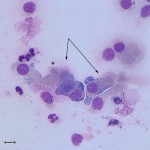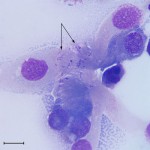Interpretation
Suppurative inflammation with Bordetella bronchiseptica
Explanation
The direct and sediment smears are of moderate cellularity consisting of moderate numbers of ciliated columnar respiratory epithelial cells and moderate numbers of mildly degenerate neutrophils. Numerous pleomorphic coccobacilli bacteria are found adhered to the cilia of the respiratory epithelial cells and in the background. The bacteria were gram-negative on a Gram-stained smear (not shown). The morphologic features of the bacteria and close association with the cilia of the respiratory epithelial cells are characteristic features of Bordetella species.
The hyperphosphatemia, hypoglobulinemia, and lymphocytosis can be normal findings in young animals. The mild mature neutrophilia most likely reflects inflammation, although an endogenous corticosteroid-mediated (stress) response cannot be completely excluded.
 |
 |
Discussion
Bordetella bronchiseptica is a gram-negative, aerobic coccobacillus that colonizes the respiratory tract of several species including dogs, cats, pigs, rabbits, and humans. It is one of the primary causative agents of canine infectious tracheobronchitis (“kennel cough”), an acute, highly contagious and often self-limiting infection in dogs that most often manifests as a loud hacking cough.1,2 B. bronchiseptica has also been isolated from pigs with atrophic rhinitis and rabbits with upper respiratory signs (“snuffles”).3,4 Human infections with B. bronchiseptica have been reported, usually in immunocompromised individuals. Other Bordetella species (B. pertussis and B. parapertussi) cause whooping cough in children.5 B. bronchiseptica is transmitted via direct contact with infected individuals, aerosolized droplets, or fomites.1 The organisms colonize the ciliated epithelial cells of the respiratory tract via adhesion molecules such as fimbriae and filamentous hemagglutinin.4,6 Once adhered, they secrete toxins that induce ciliostasis and the destruction of cilia, with subsequent damage to the epithelium, accumulation of mucus, and induction of an inflammatory response.5,6 Infection with B. bronchiseptica predisposes the host to develop secondary opportunistic infections that can lead to pneumonia and even sepsis. Pasteurella sp., Streptococcus sp., Pseudomonas sp., and Mycoplasma sp. have all been isolated from dogs with infectious tracheobronchitis and are associated with a more severe clinical course.
Further information and follow up
Bordetella bronchiseptica and Pasteurella sp. were isolated with routine aerobic culture of the tracheal wash fluid. Mycoplasma organisms, which require special culture conditions, were also cultured from the fluid. Based on antibiotic sensitivity results, the puppy was treated with a course of doxycycline and clinical signs resolved within several weeks.
References
- Ford RB. Canine Infectious Tracheobronchitis. In: Greene CE, ed. Infectious Diseases of the Dog and Cat. St. Louis, Mo; Saunders Elsevier, 2006;54-61.
- Egberink H, Addie D, Belak S, et al. Bordetella bronchiseptica infection in cats: ABCD guidelines on prevention and management. J. Feline Med. Surg. 2009;11:610-614.
- Rougier S, Galland D, Boucher S, Boussarie D, Vallé M. Epidemiology and susceptibility of pathogenic bacteria responsible for upper respiratory tract infections in pet rabbits. Vet Microbiol. 2006;115:192-8.
- Brockmeier SL, Register KB. Expression of the dermonecrotic toxin by Bordetella bronchiseptica is not necessary for predisposing to infection with toxigenic Pasteurella multocida. Vet Microbiol. 2007;125:284-9.
- Anderton TL, Maskell DJ, Preston A. Ciliostasis is a key early event during colonization of canine tracheal tissue by Bordetella bronchiseptica. Microbiology 2004;150:2843-2855.
- Mattoo S, Foreman-Wykert AK, Cotter PA, Miller JF. Mechanisms of Bordetella pathogenesis. Front Biosci. 2001;6:E168-86.
